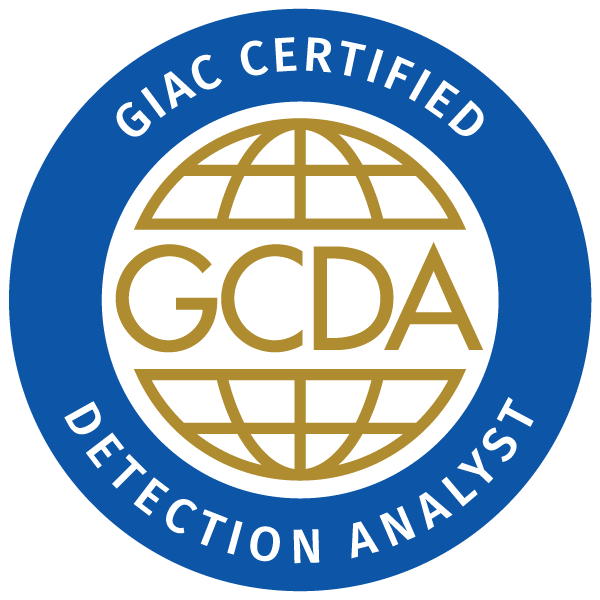GCDA is currently in abeyance and no longer available for purchase. GCDA certifications can be renewed by CPEs only.
Areas Covered
- SIEM Architecture and SOF-ELK
- Service Profiling, Advanced Endpoint Analytics, Baselining and User Behavior Monitoring
- Tactical SIEM Detection and Post-Mortem Analysis
Who is GCDA for?
- Security Analyst
- Security Architects
- Senior Security Engineers
- Technical Security Managers
- SOC Analysts
- SOC Engineers
- SOC Managers
- CND Analysts
- Security Monitoring Specialist
- System Administrators
- Cyber Threat Investigators
- Individuals working to implement Continuous Security Monitoring
- Individuals working in a hunt team capacity
Exam Format
- 1 proctored exam
- 75 questions
- 2 hours
- Minimum passing score of 79%
Delivery
NOTE: All GIAC Certification exams are web-based and required to be proctored. There are two proctoring options: remote proctoring through ProctorU, and onsite proctoring through PearsonVUE. Click here for more information.
GIAC certification attempts will be activated in your GIAC account after your application has been approved and according to the terms of your purchase. Details on delivery will be provided along with your registration confirmation upon payment. You will receive an email notification when your certification attempt has been activated in your account. You will have 120 days from the date of activation to complete your certification attempt.
Exam Certification Objectives & Outcome Statements
- Alert Analysis The candidate will demonstrate an understanding of how to analyze endpoint security logs, augment intrusion detection alerts, analyze vulnerability information, correlate malware sandbox logs, handle alerts efficiently, identify which alerts to retain and identify staff training opportunities.
- Device Discovery The candidate will demonstrate an understanding of how an environment can be more fully understood through the use of active and passive device discovery and how this understanding can be used to create baselines and detect anomolous behavior.
- Endpoint Logging Analysis The candidate will demonstrate an understanding of how to discover abnormal activity, establish baselines and optimize logging to find anomalous behavior through the use of endpoint logs, events of interest and host-based firewalls.
- Endpoint Logging Collection The candidate will demonstrate an understanding of how to identify attacks and analyze logs in both Windows and Linux environments and employ scripting to reduce log noise as well as establish collection strategies, both agentless and agent-oriented in these environments.
- Log Aggregation and Parsing The candidate will demonstrate an understanding of how log filters and message brokers can be used during data queuing and storage to enhance log retention and search response times, demonstrate an understanding of the methods and techniques used to perform analysis, analytical reporting, and alerting through the use of visualizations and detection dashboards.
- Log Collection The candidate will demonstrate an understanding of how data gathering strategies, event rates, storage requirements and staffing requirements inform SIEM planning and event logging device architecture, log monitoring for assets, data gathering and preservation strategies and techniques of log collection.
- Log Output and Storage The candidate will demonstrate an understanding of data queuing, resiliency and storage as well as how to perform analytical reporting and alerting through the use of visualizations and detection dashboards.
- Network Service Log Analysis The candidate will demonstrate an understanding of how to identify attacker characteristics, determine anomalous behavior and establish baseline behavior in common network protocol traffic such as SMTP, DNS, HTTP and HTTPS.
- Network Service Log Collection & Enrichment The candidate will demonstrate an understanding of detection methods and relevance to log analysis, analyzing common application logs, application of threat intelligence to generic network logs, correlation of network datasets and establishment of network baseline activity.
- Post-Mortem Analysis The candidate will demonstrate an understanding of how to use virtual machines and malware sandboxes, configure systems to generate event log alerts after compromise, identify unusual time-based activity and re-analyze network traffic after an incident.
- Software Monitoring The candidate will demonstrate an understanding of how to identify authorized and unauthorized software, treat scripting tools and command line parameters as a special kind of software and source collection methodology.
- User Monitoring The candidate will demonstrate an understanding of how to utilize behavior analytics when analyzing user logons, built-in accounts and system services based on patterns, use network data to discover unauthorized use or assets, configure enterprise wide baseline collection and establish large scale persistence monitoring.

